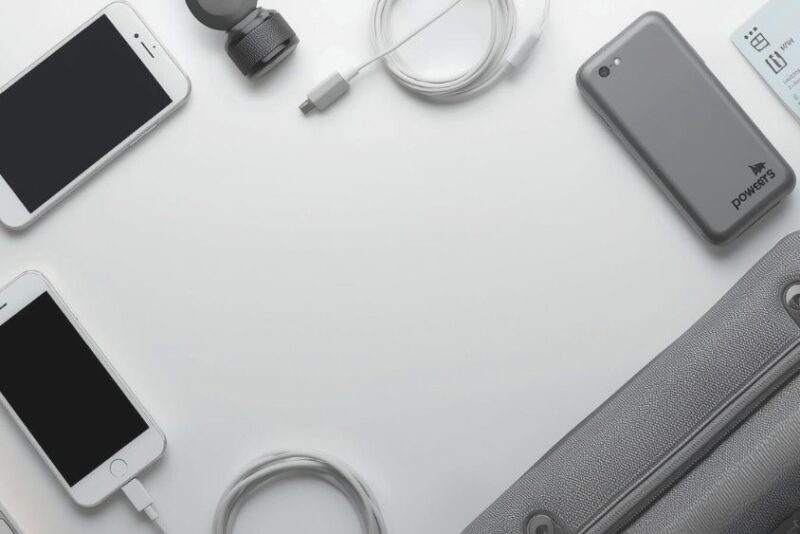So, can you bring a power bank on a plane? The short answer: yes — but only in your carry-on bag, never in checked luggage. Airlines classify power banks as spare lithium batteries, which means they have to stay with you in the cabin where the crew can monitor them if anything goes wrong.
You’re allowed to carry power banks rated up to 100 watt-hours (Wh) without restrictions. Larger ones — between 101 and 160 Wh — require airline approval, and anything above that is not allowed on passenger flights at all.
In this guide, we’ll unpack exactly why these rules exist, how to check your power bank’s Wh rating, what kinds aren’t allowed, and smart ways to pack them safely for your next flight.
Let’s find out!
Can You Bring A Power Bank On A Plane?
Yes, you absolutely can — but only in your carry-on bag or personal item, never in your checked luggage. Power banks fall under the category of spare lithium-ion batteries, which the aviation safety authorities treat with extra caution because of their potential fire risk.
When you pack yours, make sure the charging terminals are protected — either by keeping it in its original case, using a plastic cap, or simply wrapping the ports with tape. This prevents accidental short-circuiting if it touches coins, keys, or metal objects inside your bag.
You can bring multiple power banks as long as each one meets the watt-hour (Wh) limit we’ll explain below. Keep them in an easy-to-reach pocket because security officers may want to inspect them separately during screening.
Can You Take A Power Bank On A Plane Or In Your Carry-On?
Yes — and that’s the only correct way to bring it. Power banks are required to stay with you in the cabin, either in your carry-on bag or under the seat in front of you. They’re not allowed in checked luggage because if a battery overheats or catches fire, the cabin crew can respond quickly — something that isn’t possible in the cargo hold.
When packing, keep your power bank accessible, not buried deep in your backpack. TSA officers might ask you to remove it during screening, just like a laptop or tablet.
A simple travel tip: store your power bank in a separate pouch or case to avoid scratches and make it easier to show during inspection. It also prevents the terminals from rubbing against metal objects, which can cause sparks or damage over time.
Why Are Power Banks Banned In Checked Baggage?
It’s not about being picky — it’s about fire safety. Power banks use lithium-ion batteries, which pack a lot of energy in a small space. That’s great for charging your phone, but it also means that if the battery gets damaged, overheats, or short-circuits, it can catch fire through a process called thermal runaway.
If that happens in the cabin, the crew can spot smoke, use a fire containment bag, and take quick action. But if it happens in the cargo hold, no one can respond — and that’s a risk airlines can’t take. That’s why aviation authorities worldwide ban lithium power banks from checked luggage entirely.
In short: keep it where you can see it. Your safety (and everyone else’s) depends on it.
What Type Of Power Banks Are Not Allowed?
Not all power banks make it past airport security. The main factor that decides whether yours flies or not is its watt-hour (Wh) rating — basically, how much energy it holds.
- Under 100Wh: Allowed in carry-on, no approval needed.
- 101–160Wh: Allowed only with airline approval, usually limited to two units per passenger.
- Over 160Wh: Not allowed on any passenger plane — these are considered too powerful and belong in cargo shipping only.
Airlines may also reject damaged, swollen, or unlabeled batteries. If the Wh rating or brand label has rubbed off, they can legally deny it for safety reasons.
Some bulky AC-output power stations (the kind with wall plugs) often exceed 160Wh, so always check before you fly. And if you’re curious about other heat-producing travel items, our guide on can you take electric hand warmers on a plane? explains a similar safety rule.
How To Check Your Power Bank’s Wh Rating
Most travelers panic when they can’t find the watt-hour number — but it’s actually easy to calculate. Power banks usually list their capacity in milliamp-hours (mAh) and voltage (V). You just need a quick formula:
Wh = (mAh × V) ÷ 1000
For example:
- 5,000 mAh × 3.7 V = 18.5 Wh
- 10,000 mAh × 3.7 V = 37 Wh
- 20,000 mAh × 3.7 V = 74 Wh
- 26,800 mAh × 3.7 V = 99 Wh (right under the 100 Wh limit!)
If the label already shows “Wh,” even better — that’s the number security officers will check.
Keep a photo of the label on your phone just in case it fades over time.
Once you know your power bank’s rating, you’ll know exactly which category it falls into — safe, approval-needed, or not allowed.
Packing And Safety Checklist

Power banks are small but powerful — and that means they deserve careful packing. Before you zip up your carry-on, run through this quick checklist:
- Keep it in your carry-on or personal bag, never in checked luggage.
- Protect the terminals with tape, a case, or the original packaging.
- Avoid direct pressure — don’t wedge it between books or shoes.
- Don’t stack coins, cables, or metal objects near it (short circuits happen fast).
- Check for swelling or cracks — damaged batteries aren’t allowed on board.
- Keep labels visible in case officers want to verify the Wh rating.
- Remove power banks from your bag if it gets gate-checked.
Want a full preflight safety refresher? Our Travel Safety 101 guide covers simple habits that make your entire trip safer — from packing to airport security.
Airline Policy Snapshot (US)
While the general rule comes from aviation safety authorities, each airline can interpret it a bit differently. Most U.S. carriers — like American, Delta, United, Southwest, and Alaska — all follow the same FAA standard: power banks must be carried in hand luggage, not checked, and limited to 100Wh unless approved.
Some airlines also add small extras, such as asking passengers to keep power banks visible during use or to unplug them during takeoff and landing.
For the most accurate reference, you can always double-check the FAA lithium battery limits page. It’s the master guide all airlines use to
Edge Cases You Should Know
Some travel situations can make the power bank rules a little trickier. Here are the ones that catch most people off guard:
Smart luggage:
If your suitcase has a built-in power bank, it’s allowed only if the battery is removable. Airlines require you to take it out before checking in or gate-checking the bag.
Heated clothing and camera battery plates:
These use lithium packs, too, so the same carry-on rule applies. It doesn’t matter if it’s heating gloves or charging camera gear — if it has a rechargeable cell, it belongs in the cabin.
International flights:
Some non-US airlines let you carry power banks but forbid using them during the flight. Always check your airline’s website before flying abroad to avoid surprises at boarding.
Frequently Asked Questions
Can I bring two power banks on a plane?
Yes, you can — as long as each one meets the watt-hour rule. Power banks under 100Wh are fine without limits. If yours are between 101Wh and 160Wh, most airlines allow a maximum of two units, but you’ll need to get approval before flying. Anything above 160Wh isn’t allowed on passenger planes at all.
Are Anker or Baseus power banks allowed?
Absolutely. Airline rules don’t care about the brand — only about battery capacity and condition. As long as the Wh rating is within limits, the battery isn’t swollen or damaged, and the label is visible, your Anker, Baseus, or any other reputable brand is fine to bring onboard.
Do airlines check battery capacity?
Sometimes, yes. Security officers or airline staff may ask to see the label or verify the printed watt-hour rating. If your power bank doesn’t show it clearly, it’s smart to keep a photo of the label or note the calculation (Wh = mAh × V ÷ 1000). This shows you know exactly what you’re carrying and avoids unnecessary delays at screening.
Conclusion
So, can you bring a power bank on a plane? Absolutely — as long as you know the watt-hour limits and keep it in your carry-on. Once you understand the simple rule (carry-on only, under 100Wh, protect the terminals), you’ll never have to second-guess it again.
These battery rules might seem strict, but they’re rooted in real safety concerns, not red tape. A little awareness goes a long way toward making your trip smoother — and keeping everyone safe at 35,000 feet.
If you’re getting ready for your next flight, you might also like our guide on Can You Bring Snacks Through TSA Security? It covers another common airport question that can save you time (and snacks) at the checkpoint.
Want more quick answers like this? Check out our Travel FAQs Hub for more practical guides on what you can and can’t bring on a plane.
Happy travel!
